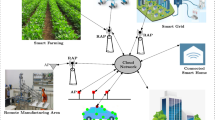Abstract
The IEEE 802.11ax standard defined a set of new specifications to improve spectrum efficiency, power efficiency, and reliability of future wireless local area networks (WLANs). Among these specifications, the uplink multi-user multiple-input, multiple-output (MU-MIMO) remedies the uplink shortcomings of existing WLANs and enables high-efficiency uplink transmissions. This paper considers the problem of adaptive modulation and coding (AMC) for uplink MU-single-input, multiple-output (MU-SIMO) in the upcoming WLANs. Our target is to select the appropriate modulation and coding scheme (MCS) for the existing users so as to maximize the throughput and at the same time guarantee that all users can satisfy a frame error constraint. We adopt a deep learning approach to tackle this problem. We propose to let the access point (AP) leverage the estimated channel state information (CSI) of all users along with the estimated noise standard deviation as the input features to a deep convolutional neural network (DCNN) that is trained to perform AMC. Simulation results reveal that the proposed DCNN for the uplink MU-SIMO AMC outperforms rival machine learning techniques such as fully-connected deep neural network (DNN), k-nearest neighbors (KNN), support vector machines (SVM), Gaussian Naive Bayes (GNB), and random forest (RF) in terms of the throughput and the frame error rate (FER).










Similar content being viewed by others
References
Elwekeil, M., Alghoniemy, M., Muta, O., Abdel-Rahman, A., Furukawa, H., & Gacanin, H. (2014). A maxmin model for solving channel assignment problem in IEEE 802.11 networks, In Proceeding of 22nd European Signal Processing Conference (EUSIPCO), Lisbon, Portugal, pp. 146–150, Sep.
IEEE 802.11, Part 11: Wireless LAN medium access control (MAC) and physical layer (PHY) specifications: enhancements for higher throughput amendment 4: Enhancements for very high throughput for operation in bands below 6 GHz, IEEE 802.11 Std., (Dec. 2013).
Khorov, E., Kiryanov, A., Lyakhov, A., & Bianchi, G. (2019). A tutorial on IEEE 802.11 ax high efficiency WLANs. IEEE Commun. Surv. Tutor., 21(1), 197–216.
Sung, C.-K., Chung, S.-Y., Heo, J., & Lee, I. (2007). Adaptive bit-interleaved coded OFDM with reduced feedback information. IEEE Trans. Commun., 55(9), 1649–1655.
Peng, F., Zhang, J., & Ryan, W. E. (2007). Adaptive modulation and coding for IEEE 802.11n,” In Proceeding IEEE Wireless Communication Network Conference, Kowloon, Hong Kong, Mar. 1–15, 2007, pp. 656–661.
Li, J., & Stefanov, A. (2008). Exact pairwise error probability for block-fading MIMO OFDM systems. IEEE Trans. Veh. Technol., 57(4), 2607–2611.
Daniels, R. C., Caramanis, C. M., & Heath, R. W. (2010). Adaptation in convolutionally coded MIMO-OFDM wireless systems through supervised learning and SNR ordering. IEEE Trans. Veh. Technol., 59(1), 114–126.
Daniels, R., & Heath, R. W. (2010) . Online adaptive modulation and coding with support vector machines, In Proceedings of European wireless conference (EW), pp. 718–724.
Puljiz, Z., Park, M,. & Heath, R., Jr. (2011). A machine learning approach to link adaptation for SC-FDE system, In Proceedings of IEEE global telecommunications conference - GLOBECOM, Houston. TX, USA, pp. 1–5.
Rico-Alvarino, A., & Heath, R. W., Jr. (2014). Learning-based adaptive transmission for limited feedback multiuser MIMO-OFDM. IEEE Trans. Wireless Commun., 13(7), 3806–3820.
Goodfellow, I., Bengio, Y., & Courville, A. (2016). Deep learning. Cambridge, MA, USA: MIT Press, 2016. [Online]. Available: http://www.deeplearningbook.org
Saxena, V., Jaldén, J., Bengtsson, M., & Tullberg, H. (2018). Deep learning for frame error probability prediction in BICM-OFDM systems. In Proceedings international conference on acoustics, speech and signal processing (ICASSP). IEEE, pp. 6658-6662.
Dong, Z., Shi, J., Wang, W., & Gao, X. (2018). Machine learning based link adaptation method for MIMO system. In Proceedings of international symposium on personal, indoor and mobile radio communications (PIMRC). IEEE, pp. 1226–1231.
Elwekeil, M., Jiang, S., Wang, T., & Zhang, S. (2019). Deep convolutional neural networks for link adaptations in MIMO-OFDM wireless systems. IEEE Wireless Communications Letters, 8(3), 665–668.
Elwekeil, M., Wang, T., & Zhang, S. (2019). Deep learning for joint adaptations of transmission rate and payload length in vehicular networks, Sensors, 19(5)
Bellalta, B., & Kosek-Szott, K. (2019). AP-initiated multi-user transmissions in IEEE 802.11 ax WLANs. Ad Hoc Netw., 85, 145–159.
Son, Y., Kim, S., Byeon, S., & Choi, S. (2018). Symbol timing synchronization for uplink multi-user transmission in IEEE 802.11 ax WLAN. IEEE Access, 6, 72962–72977.
Bankov, D., Didenko, A., Khorov, E., & Lyakhov, A. (2018). OFDMA uplink scheduling in IEEE 802.11ax networks. In: Proceedings IEEE international conference communication (ICC)
Lee, J., Park, J., Kim, K. L., & Nam, J. (2017). Sample-level deep convolutional neural networks for music auto-tagging using raw waveforms, In Proceedings 14th sound music computing conference (SMC), pp. 220–226.
Khan, S., Rahmani, H., Shah, S. A. A., & Bennamoun, M. (2018). A guide to convolutional neural networks for computer vision. In Synthesis lectures on computer vision
Kingma, D. P., & Ba, J. (2015) . Adam: a method for stochastic optimization, In Proceedings 3rd international conference learning representation (ICLR), pp. 1–13.
Liu, J., Porat, R., & Jindal, N. et al. (2014). IEEE 802.11 ax channel model document, In: IEEE 802.11 ax task group.
Funding
This work was supported by the Natural Science Fund of Guangdong Province under Grant 2020A1515010708.
Author information
Authors and Affiliations
Corresponding author
Additional information
Publisher's Note
Springer Nature remains neutral with regard to jurisdictional claims in published maps and institutional affiliations.
This work was done in the period 2019-2020 when Mohamed Elwekeil was affiliated with Shenzhen University and Menoufia University.
Rights and permissions
About this article
Cite this article
Elwekeil, M., Wang, T. & Zhang, S. Deep learning based adaptive modulation and coding for uplink multi-user SIMO transmissions in IEEE 802.11ax WLANs. Wireless Netw 27, 5217–5227 (2021). https://doi.org/10.1007/s11276-021-02803-y
Accepted:
Published:
Issue Date:
DOI: https://doi.org/10.1007/s11276-021-02803-y




